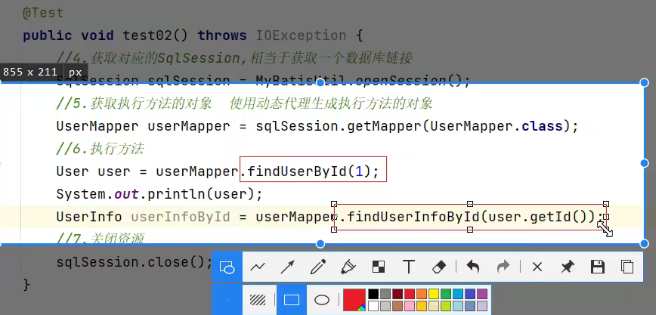相关实体类
- 【注意:定义实体时,基本类型应选用包装类;如果不使用包装类,初始化对象后会有一个默认值,在update修改数据时,会影响null的判断】
//封装User表的数据 public class User { private Integer id; private String username; private Date birthday; private String sex; private String address; //关联userinfo对象,作为属性放进来 private UserInfo userInfoDate; //关联order对象,作为属性放进来 //因为是一对多,所以封装为list对象 private List<Order> userOrderList; //关联Role的对象,作为属性放进来 //因为是一对多,所以封装成list对象 private List<Role> roleList; ....//封装userinfo表的数据 public class UserInfo { private Integer id; private Double height; private Double weight; private Integer married; ....//封装order表的数据 public class Order { private Integer oId; private Integer userId; private String number; private Timestamp createTime; private String note; ....//封装role表的数据 public class Role { private Integer roleId; private String roleName; private String roleDetail; //因为role与user是一对多的关系,所以封装为list对象 private List<User> userList; ....
多表查询
一对一关联
//根据用户ID查询用户信息 List<User> findUserById(int id);<!-- 多表查询时,即使类的成员变量名和数据库字段名一致,也不会完成自动映射,需要手写对应关系 association标签:配置一对一的关系 collection标签:配置一对多的关系 --> <resultMap id="UserMap" type="User"> <id column="id" property="id"/> <result column="username" property="username"/> <result column="birthday" property="birthday"/> <result column="sex" property="sex"/> <result column="address" property="address"/> <!-- association:一对一的映射 --> <association property="userInfoDate" resultMap="InfoMap"/> </resultMap> <resultMap id="InfoMap" type="UserInfo"> <id column="id" property="id"/> <result column="height" property="height"/> <result column="weight" property="weight"/> <result column="married" property="married"/> </resultMap> <select id="findUserById" resultMap="UserMap"> select * from user inner join user_info on user.id=user_info.id where user.id=#{id}; </select>
一对多的关联
//根据用户ID查询用户信息及其订单 User findUserAndOrder(int id);<resultMap id="UserMap" type="User"> <id column="id" property="id"/> <result column="username" property="username"/> <result column="birthday" property="birthday"/> <result column="sex" property="sex"/> <result column="address" property="address"/> <!--<association property="userInfoDate" resultMap="InfoMap"/>--> <collection property="userOrderList" resultMap="OrderMap"/> </resultMap> <resultMap id="OrderMap" type="Order"> <id column="oid" property="oId"/> <result column="user_id" property="userId"/> <result column="number" property="number"/> <result column="create_time" property="createTime"/> <result column="note" property="note"/> </resultMap> <select id="findUserAndOrder" resultMap="UserMap"> select * from user left outer join tb_order on user.id=tb_order.user_id where user.id=#{id}; </select>
多对多关联
//根据用户id查询用户关联的角色信息 User findUserAndRoles(int id);<resultMap id="UserMap" type="User"> <id column="id" property="id"/> <result column="username" property="username"/> <result column="birthday" property="birthday"/> <result column="sex" property="sex"/> <result column="address" property="address"/> <!--<association property="userInfoDate" resultMap="InfoMap"/>--> <!--<collection property="userOrderList" resultMap="OrderMap"/>--> <collection property="roleList" resultMap="RoleMap"/> </resultMap> <resultMap id="RoleMap" type="Role"> <id column="role_id" property="roleId"/> <result column="role_name" property="roleName"/> <result column="role_detail" property="roleDetail"/> </resultMap> <select id="findUserAndRoles" resultMap="UserMap"> select * from user inner join user_role on user.id=user_role.user_id inner join role on user_role.role_id=role.role_id where user.id = #{id} </select>//根据角色id查询角色信息以及相关的用户信息 Role findRoleAndUsers(int id);<resultMap id="RoleMap2" type="Role"> <id column="role_id" property="roleId" /> <result column="role_name" property="roleName" /> <result column="role_detail" property="roleDetail" /> <collection property="userList" resultMap="UserMap2"/> </resultMap> <resultMap id="UserMap2" type="User"> <id column="id" property="id"/> <result column="username" property="username"/> <result column="birthday" property="birthday"/> <result column="sex" property="sex"/> <result column="address" property="address"/> </resultMap> <select id="findRoleAndUsers" resultMap="RoleMap2"> select * from role inner join user_role on role.role_id=user_role.role_id inner join user on user_role.user_id=user.id where role.role_id = #{id} </select>
级联查询
在xml里将若干个子查询进行级联,先查询出一部分数据,再做另一部分的查询
- 在调用findUserById2方法时,会对User的基本信息进行查询,但是User类中除了包含基本信息外,还有userInfoDate、userOrderList等数据需要确定,如果resultMap中有对这些数据配置查询方法,则会通过配置的findUserInfoById2、findOrderByUserId2方法传递相关参数进行后续查询
- resultMap中的一些参数
select="方法名"第二个查询的方法column="id"传递给第二个查询的参数fetchType="lazy"懒加载,使用到的时候在进行第二个查询语句
//级联查询 //根据用户ID查询用户的基本信息 User findUserById2(int id); //根据用户ID查询用户的扩展信息 UserInfo findUserInfoById2(int id); //根据用户ID查询用户的订单信息 List<Order> findOrderByUserId2(int id);<!-- 级联查询 --> <resultMap id="UserMap3" type="User"> <id column="id" property="id"/> <result column="username" property="username"/> <result column="birthday" property="birthday"/> <result column="sex" property="sex"/> <result column="address" property="address"/> <association property="userInfoDate" select="findUserInfoById2" column="id" fetchType="eager"/> <collection property="userOrderList" select="findOrderByUserId2" column="id" fetchType="lazy"/> </resultMap> <select id="findUserById2" resultMap="UserMap3"> select * from user where id=#{id} </select> <select id="findUserInfoById2" resultType="cn.org.none.pojo.UserInfo"> select * from user_info where id=#{id} </select> <select id="findOrderByUserId2" resultType="cn.org.none.pojo.Order"> select * from tb_order where user_id=#{id} </select>
- 但在开发中常用的是在方法中进行子查询嵌套
注解开发
注解开发可以在接口文件中完成简单功能,无需在映射文件中编写
//注解开发 //查询所有的User的数据 @Select("select * from user") List<User> selectAllUsers3(); //新增User对象 @Insert("insert into user values (null,#{username},#{birthday},#{sex},#{address})") int insertUser3(User user); //修改User对象地址 @Update("update user set address=#{address} where id =#{id}") int updateUser3(User user); //删除User对象 @Delete("delete from user where id=#{id}") int deleteUser3(int id);
MyBatis缓存
MyBatis框架中缓存分为一级缓存和二级缓存,通过缓存策略可以减少查询数据库的次数,提升系统性能
一级缓存
- 默认开启
- 在同一个sqlSession范围内部有效
- 当调用sqlSession的修改、添加、删除、提交、关闭等方法时,一级缓存会被清空;也可以手动调用
sqlSession.clearCache()进行清理
- 二级缓存
- 开启条件
- 在实例类中实现Serializable接口,如果涉及多表查询,则每个实体类都需要实现这个序列化
- 在mybatis-config.xml的setting里面需要设置开启二级缓存:
<setting name="cacheEnabled" value="true"/> - 在Mapper.xml映射文件的
标签中添加 <cache/>标签,开启二级缓存使用
- 存在Mapper中,在多个sqlSession中共享
- 只有在前一个sqlSession中调用close()后才会缓存
- 开启条件
